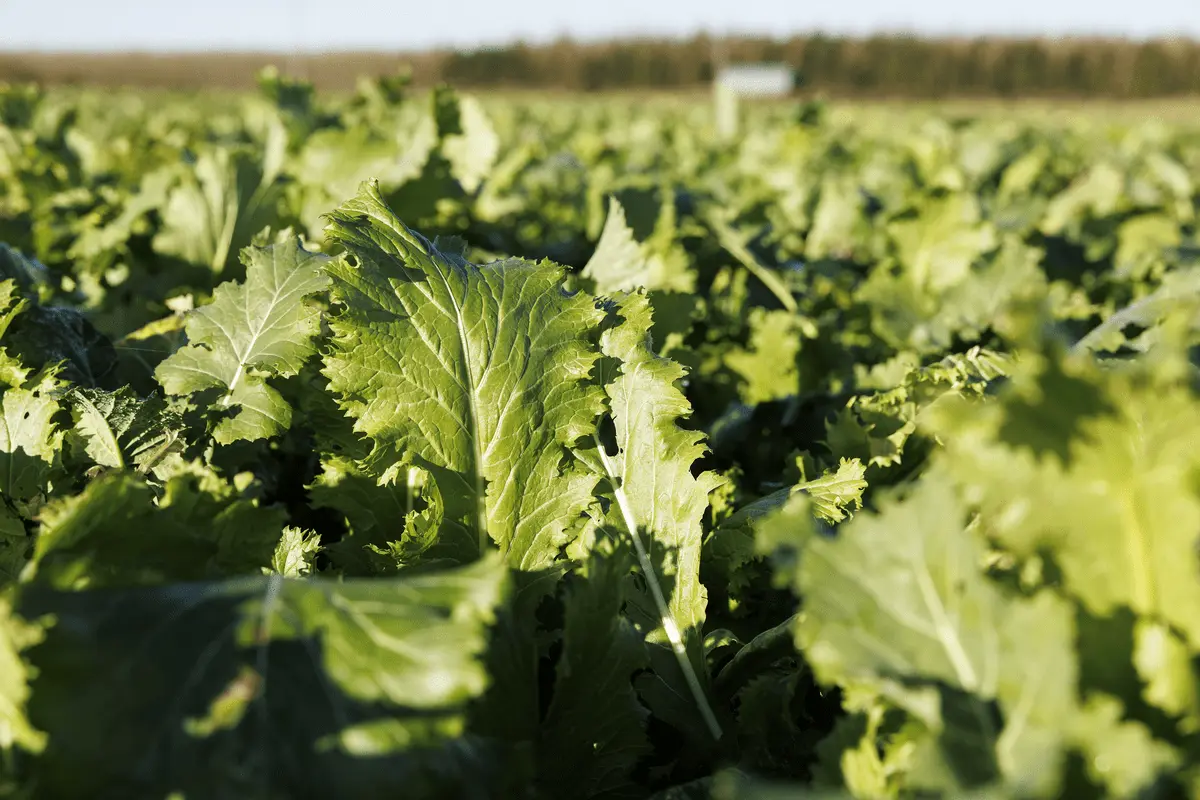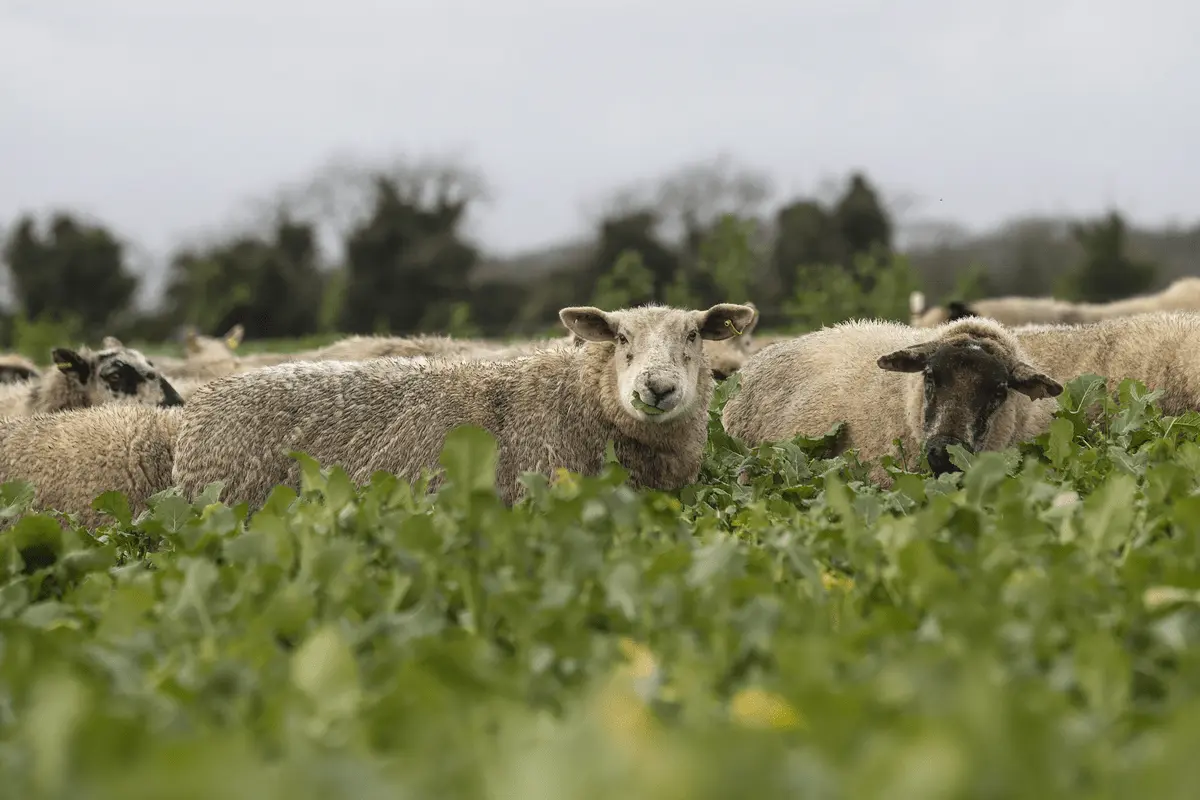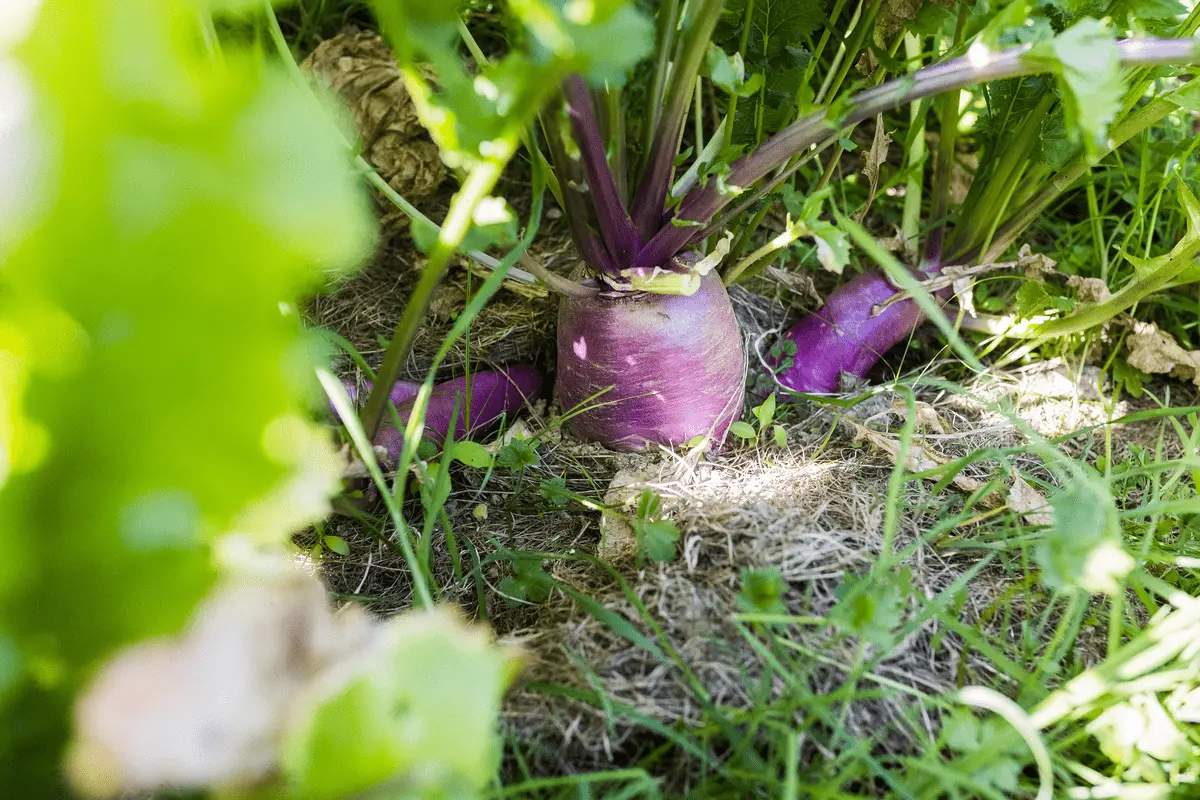Homegrown forage crops are cutting feeding costs and filling feeding gaps. Brassica seed can produce a wide variety of forage crops that offer dairy, beef and sheep farmers in the UK valuable alternative sources of home-produced feed.
From the leafy kales and forage rapes, to root crops, including stubble turnips and swedes, brassica seed can be used by farmers produce a versatile feeding solution to fill summer grazing gaps, extend autumn grazing, or support out-wintering systems.
What are brassica forage crops?
British farmers can sow brassica seed to establish nutritious brassica forage crops such as kale, stubble turnips, grazing turnips, hybrid brassicas and forage rape. Brassicas (Brassicaceae) can be sown in spring or summer and are especially useful for outwintering.
Contents
- Benefits of planting brassica crops
- Planning your brassica forage crops
- Site selection for out-wintering
- Preparation for growing brassicas
- Growing brassica seed effectively
- Brassica grazing management
- Brassica crop utilisation
- Average yields and stocking guidelines for brassica crops
- Calculating daily brassica feed allocation
Benefits of planting brassica crops
Feed cost savings
- Brassica forage crops can cost from just 25p per head per day
- Economic solution to summer grazing deficiencies
- Reduce the need for winter-conserved forage
- Limit reliance on bought-in concentrates
Brassica crop rotation benefits
- Pioneer crops for previously uncultivated areas
- Valuable break before pasture renewal
- Forage brassicas are good break crops to restore soil health in arable and grassland grazing situations
Overall enterprise profitability
- Extended grazing season
- Increase output per hectare
- Reduce labour, machinery and housing costs
Health, welfare and environment
- Avoid housing-related health problems by outwintering cattle
- Reduce fuel required for silage and bought-in feeds
- Limit the risk of forage brassica shortages due to drought
Planning your brassica forage crops
Integrating brassicas into your system: to make the best use of brassica forage crops within your existing system, follow this three-step guide to establish your basic approach.
Step one: When do you want your cattle to be grazing brassicas?
Brassica crops can be grown to provide quality grazing from June right through to February or March. They can, therefore, be used to supplement summer grazing, extend autumn grazing or support out-wintering systems.
Step two: When does the land required become vacant?
Brassica crops should be seen as a valuable part of the farm’s rotational policy, so it is best to plan your cropping and utilisation within this bigger picture. Versatile modern varieties and new fast-growing cropping options do, however, mean that most requirements can be accommodated.
Step three: How much land do I need to sow brassica seed?
First, decide the number and type of livestock you are planning to feed with the brassicas and for how long. Then determine the most appropriate brassica seed, based on your deliberations from steps one and two. Calculate the area required using the guidelines provided in the section ‘Feeding brassicas to livestock’.
Plan fibre feeding in advance
Livestock grazing brassicas must have access to straw or haylage, sufficient to provide at least 30% of the daily dry matter ration. In brassica crops grown for late autumn grazing, or outwintering, bales should ideally be placed in the field while ground conditions are still dry.
This minimises the risks of soil compaction, run-off from tractor wheeling, and reduces labour requirements during the feeding period. Essential run-back areas (loafing/grazing areas at the end of fields) will also contribute to the fibre component of the ration in the form of deferred grazing.

Site selection for outwintering cattle in the UK
Forage brassica seed is being grown successfully in many situations in the UK. However, it is important to select the optimum site for brassica forage crops in order to achieve the best results in terms of enterprise performance, and also to ensure that all cross-compliance requirements are met.
Ideal situation for site selection
- Fields where grass production is falling and a break crop is required
- A minimum of five years since the last brassica crop to minimise disease risks
- Avoid heavier soil types for outwintering cattle
- No threat to watercourses
- Avoid steeply sloping sites
- Good airflow for rapid drying
- Suitable shelter for livestock
Preparation for growing brassicas from seed
Soil test at least eight weeks prior to planned sowing date, but ideally the previous winter and before any FYM is applied.
Best results are achieved with thorough preparation
- Retain topsoil strength and resilience to trampling, which can be done by drilling directly into a glyphosate-treated sward
- Apply fertiliser and/or lime to achieve pH 5.8-6.5 and P&K indices of 2
- Organise fencing to exclude watercourses but allow continuous access to drinking troughs
- Plan your utilisation to ensure downward grazing of slopes and move electric fencing frequently
- Use back fencing to avoid poaching and protect regrowth
- Allow for run-back for gradual introduction and suitable lying space
- Consider using grassland buffers alongside vulnerable watercourses
- Have a fall-back plan in the event of extremely bad weather
Growing brassica seed effectively
Conventional cultivation to achieve a fine, firm and clean seedbed is the most common practice for establishing brassicas, but direct drilling is an option if conditions allow.
Typical establishment regime
- Spray with glyphosate when pasture or weed cover around 2,000 kg DM/ha (8-10 cm sward height)
- After five to seven days, graze hard, or cut to remove as much vegetation as possible
- Apply fertiliser on the basis of earlier soil tests
- Prepare a fine, firm and clean seedbed through cultivations
- If cultivating, broadcast brassica seed, harrow and roll; or direct drill and roll
- Brassica seed should be sown at approximately 1 cm deep, whatever the establishment method
When to plant brassica seeds: Timing and seed rates
Brassica seed should ideally be drilled when soil temperatures are around 10°C and rising, with optimum timing dependent upon crop type and variety.
Seed rates should typically be between 5-7.5 kg/ha (2-3 kg/acre) depending on crop type and variety. Marginally higher seed rates are recommended when broadcasting compared with direct drilling. (See 2.3)
Monitoring the growing crop
Brassica crops must be monitored closely for pests, diseases and weed ingress at all times, particularly during the critical establishment phase (first six weeks).
| Challenges of growing brassicas | Optimum solutions |
| Weeds | Weeds should be controlled in the previous brassica crop or through spraying before cultivation – pre-emergence herbicides can be an option |
| Slugs | Roll after drilling – apply slug pellets if problems occur post-emergence |
| Sawfly, cabbage white butterfly, diamondback moth | Cost-effective to use insecticidal sprays if detected at an early stage |
| Clubroot | Five-year rotational policy – use more resistant varieties such as Swift and Redstart hybrid brassica |
| Foliar fungal diseases | Select resistant varieties |
| Dry rot (swedes) | Brassica crop rotation – use boron fertiliser |
In all pest, disease, and weed control situations, seek advice from a qualified agronomist on the most appropriate treatments and application rates.
Brassica fertiliser requirements
| Brassica crop varieties | Nitrogen (kg/ha) (units/acre) | Phosphate P2O5 kg/ha (units/acre) | Potash (K2) kg/ha (units/acre) | N applied at sowing (% of total) | N applied later (% of total) |
| Swedes | 100-120 (80-96) | 75-100 (60-80) | 75-100 (60-80) | 50% | 50% at 10-12 weeks |
| Kale | 100-120 (80-96) | 80 (65) | 80 (65) | 50% | 50% at 10-12 weeks |
| Stubble turnips | 50-80 (40-64) | 70 (55) | 70 (55) | 60% | 40% at 6-8 weeks |
| Grazing turnips | 40-60 (32-48) | 30-40 (24-32) | 30-40 (24-32) | 100% | Further N can be applied for regrowth |
| Forage rape or hybrid brassica | 50-80 (40-64) | 40-60 (32-48) | 40-60 (32-48) | 100% | Further N can be applied for regrowth |
Brassica grazing management
Forage brassicas are ideal grazing crops and hence offer all the cost-saving advantages of reduced housing, bedding, conservation, feed-out, muck handling, and so on.
To maximise the efficiency of grazing and to minimise wastage, strip grazing with electric fences needs to be well managed. Strips (breaks) should be long and narrow to allow all the animals access to the crop at one time, minimise poaching, and improve crop utilisation.
The fence should ideally be moved daily, with the area provided being calculated on the basis of the brassica crop’s production and stock requirements.

Key brassica grazing guidelines
- Introduce stock to forage brassica varieties gradually and with full stomachs (1-2 hours/day initially and building to unrestricted access in 7-10 days)
- Always allow access to a run-back area
- Provide supplementary fibre as hay, haylage, or straw at all times
- Cows in milk should receive no more than 30% of their daily dry matter intake as brassicas
- Always make the appropriate minerals available
- Allow easy access to water
Multiple brassica grazing
Several brassica forage crops, including Swift hybrid brassicas and Redstart and Appin turnips, have the potential to regenerate after grazing, offering the possibility of multiple grazing. Here are the key guidelines:
- Sow your brassica seed mix or straight no later than early June to allow time for multiple grazing
- Graze in blocks as opposed to strips, and take care to minimise crop damage
- Ensure stock have access to clean water
- Move stock on to leave 12-15 inches (30-40 cm) of stem with ample growing points for regrowth
- Replace bales as a fibre source between grazings
Brassica varieties and crop utilisation
The target with any brassica forage crop should be to achieve at least 85-90% crop utilisation, minimising the amount of forage remaining in the field. Choose types of brassica varieties with the characteristics to encourage intake and maximise utilisation.
Kale brassica
Maris Kestrel kale has a high leaf-to-stem ratio and minimal stem rejection once successfully sown from kale seeds.
Hybrid brassica
Swift and Redstart hybrid brassicas have been shown in field trials* to have superior utilisation of stem.
Grazing turnips
Appin turnips has a high leaf-to-bulb ratio to provide a highly palatable forage for rapid field clearance. Meanwhile, Vollenda stubble turnips can be used for summer grazing shortfalls.

Average yields and stocking guidelines for brassica crops
Animals/ha for 100 days (70% of diet)
| Brassica crop varieties | DM (kg/ha) | DM (%) | ME (MJ/kg) | Cows | Youngstock | Ewes | Finishing lambs |
| Swedes | 9-14,000 | 10-12 | 12-14 | 15 | 14 | 83 | 65 |
| Kale | 11-12,000 | 12-15 | 10-13 | 19 | 18 | 107 | 84 |
| Stubble turnips | 6,500 | 9-12 | 10-13 | 11 | 10 | 63 | 49 |
| Grazing turnips | 4,000 | 10-14 | 10-13 | 9 | 8 | 49 | 38 |
| Hybrid brassica | 7-10,000 | 10-14 | 10-13 | 11 | 10 | 63 | 49 |
| Forage rape | 4-5,000 | 10-13 | 10-13 | 7 | 6 | 30 | 30 |
Assumptions
- Cow liveweight 500 kg (adjust upwards for dairy cows)
- Youngstock liveweight gains 0.75 kg/day
55 kg ewes on maintenance feeding - Lamb liveweight gains 200 g/day
- Dairy cows should be restricted to no more than 30% of daily dry matter intake as brassicas, to avoid the risk of milk taint
Measuring dry matter yield and calculating daily grazing requirements
For accurate feed planning it is essential to measure the DM yield of your crop. This is easily achieved using:
- 1 m square frame
- Seed bag
- Pair of garden shears
- Some scales
Follow this four-step guide for collecting DM yield samples
Several samples should be taken from each field, picking representative sampling points:

Calculating daily brassica feed allocation
| Brassica feed allocation (based on a 270 kg weanling requiring 8 kg DM/day) | Your livestock and forage crop requirements |
| 1. Livestock total intake estimate (based on 3% DM requirement of liveweight) | 8 kg DM/day |
| 2. Brassica grazing percentage of diet | 70%* |
| 3. Brassica daily requirement (box 1 x box 2) | 5.6 kg DM |
| 4. Number of livestock | 25 |
| 5. Daily brassica requirement (box 3 x box 4) | 140 kg DM |
| 6. Estimate forage crop DM yield/m²** | 0.8 kg DM/m² |
| 7. Total daily brassica grazing area required (box 5/box 6) | 175 m² of brassica |
| 8. Fence length | 120 m |
| 9. Fence to be moved (box 7/box 8) | 1.5 m/day |
* Maximum of 30% of diet DM for lactating cows
** Based on crop yields of 10tDM/ha (1 kg/m2) x 80% utilisation
Grazing management is important to optimise the potential of brassica crops. Strip grazing small areas will provide the most efficient utilisation. Grazing in larger areas will increase trampling and waste of available forage.
Maintaining animal health on brassicas
With the correct management, livestock will thrive on brassicas. A best practice approach that will ensure livestock remain healthy, and there are no other issues, is as follows:
- Check livestock twice a day when feeding brassicas
- Avoid introducing animals to brassicas when hungry
- Introduce animals to brassicas slowly, over a 10-day period
- Always provide a fibre source to ensure no more than 70% of DM diet is brassica
- With milking cows, the brassica ration should be no more than 30% of the DM ration in order to avoid the risk of milk taint
- Transition pregnant cows off brassicas four to six weeks pre-calving
If in any doubt about the health of livestock on brassicas, reduce the proportion of the diet being fed (please consult your vet regarding any animal health issues).
Brassica crops webinar: How to fill the forage gap
Ask an expert about brassica seed
You can contact a Germinal forage expert if you need to discuss sowing brassica seed effectively.
